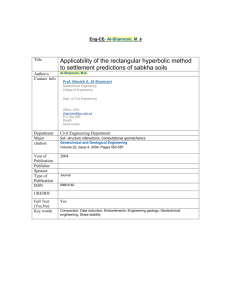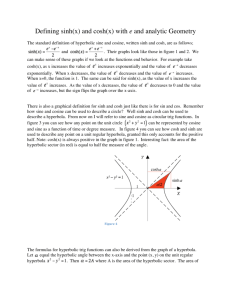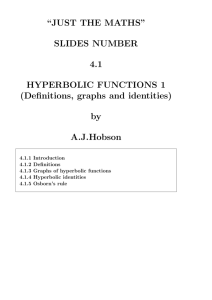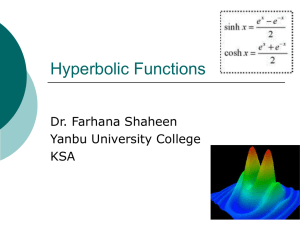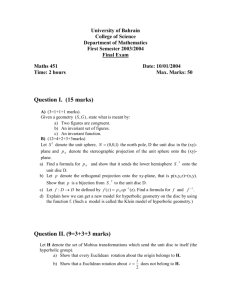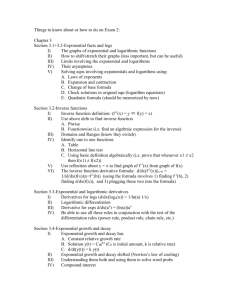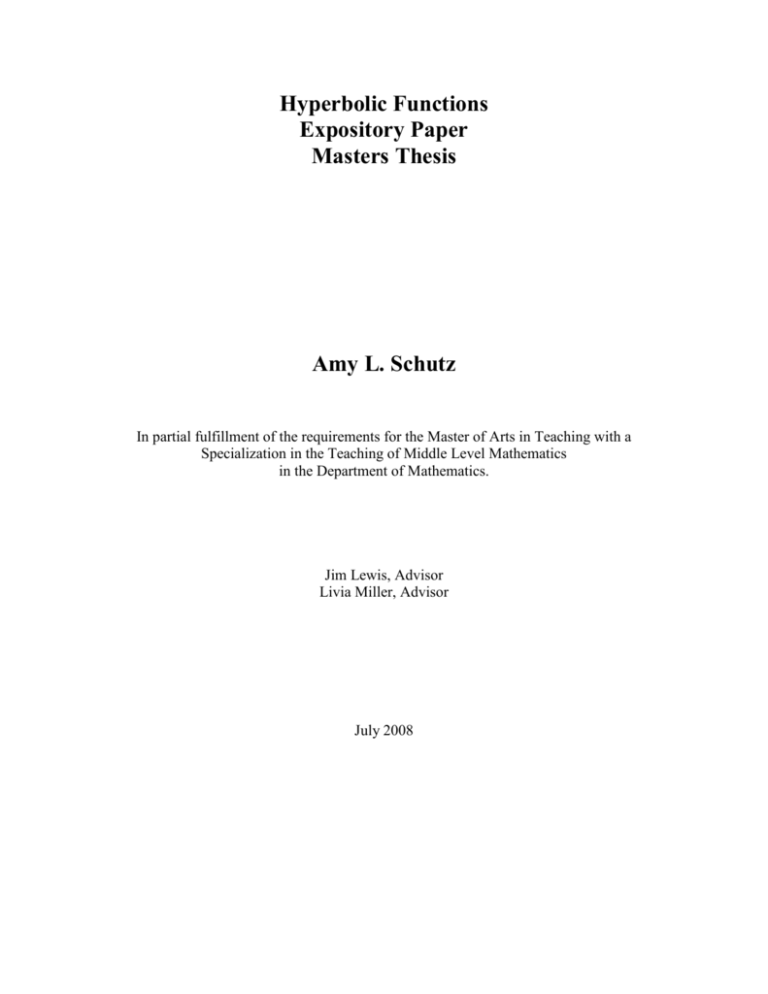
Hyperbolic Functions
Expository Paper
Masters Thesis
Amy L. Schutz
In partial fulfillment of the requirements for the Master of Arts in Teaching with a
Specialization in the Teaching of Middle Level Mathematics
in the Department of Mathematics.
Jim Lewis, Advisor
Livia Miller, Advisor
July 2008
Introduction
This is a paper about hyperbolic functions; a class of functions that are, as we
shall see, analogous to the trigonometric functions. We will discuss the history of the
development of hyperbolic functions, their properties, their relationship to trigonometric
functions and to hyperbolas, and explore some applications of these interesting functions.
Hyperbolic functions arise quite naturally from simple combinations of the
exponential function, ex, a function that is explored thoroughly in school mathematics.
Indeed, the two main functions, the hyperbolic cosine and the hyperbolic sine are just half
of the sum and difference of ex and e-x, namely:
cosh(x)
sinh( x)
ex
e x
2
x
e e x
2
Of course, while it is natural to create these combinations of the exponential function, our
choice of names for these two functions raises the question of where the names come
from. We intend to answer this question and more.
History
An Italian mathematician, Vincenzo Riccati, developed the hyperbolic functions
in the mid-18th century. Ricatti studied hyperbolic functions and employed them to obtain
solutions of cubic equations. He also found the standard addition formulas, similar to
trigonometric identities, for hyperbolic functions as well as their derivatives. Ricatti’s
approach did not begin with the definition we gave above. Instead, with some work done
jointly with Saladini, he found the relationship between the hyperbolic functions and the
exponential function. His work was published between 1757 and 1767. Ricatti used Sh.
and Ch. as notation for the hyperbolic sine and cosine and used the similar abbreviations
of Sc and Cc for the circular functions, sine and cosine.
Despite what is now a general agreement that Ricatti first introduced the
hyperbolic functions, a French mathematician by the name of Johann Heinrich Lambert
has often been credited for their introduction. In 1768, Lambert published his work
concerning on hyperbolic functions, in which he made the first systematic development
of their theory. Thus Lambert became associated with hyperbolic functions in the same
way that Leonard Euler is associated with circular functions; Lambert popularized the
new hyperbolic trigonometry as it is used in modern science. Lambert began using the
notation of sinh x, the Latin sinus hyperbolus, and cosh x to represent these functions.
This notation is widely used today although in some cases one can also find the notation
hysin and hycos that George Minchin introduced in 1902.
Although hyperbolic functions were not introduced until around the late 1750’s,
almost two hundred years earlier Gerhard Kremer made the first and one of the most
important applications of the functions we now know as hyperbolic. Kremer was a
Flemish geographer who was better known by his Latin name, Gerhardus Mercator. In
1569, he issued his Mercator’s Projection map. The projection resulted in the making of a
map in which a straight line always made an equal angle with every meridian. This was a
major breakthrough in navigation and is used today in all deep-sea navigation charts of
the world. However, when he published his work, it was left to others to discover that the
formulas he used were linked to the hyperbolic functions.
Modern interest in hyperbolic functions increased with the invention and
commercialization of electricity. The widespread use of electricity started in the mid
1850’s with the development of telegraphs. This was followed by the telephone, electric
light, and the need of industry for power. Generating plants and transmission lines started
to cross America and this transmission of electrical power involves the application of
hyperbolic functions. Finally, during the early decades of the 1900’s, applications of
hyperbolic functions could be found in every scientific discipline.
Hyperbolic Functions
Hyperbolic functions are similar to trigonometric or circular functions. Just as the
trigonometric functions are related to the circle, the hyperbolic trigonometric functions
are related to the standard hyperbola: x 2
y2
1 for x > 1. For example, using our
definition above, we can show that cosh2 ( x) sinh 2 ( x) 1. Namely,
2
2
cosh x sinh x
ex
e
2
x
ex
e
2
ex
e
4
1 x
e
4
2
2
x 2
e
2e xe
1 2x
e
4
2e x e
x
ex
x 2
1 2x
e
4
1 x
4e e
4
x
e
4
ex
x
x
x 2
e
e
e
2x
2x
x 2
e2 x
e2 x
2e x e
2e x e
x
x
e
e
2x
2x
e xe
x
1
We can also use circular trigonometric identities, and some information about complex
numbers, to help us derive the formulas for the hyperbolic functions.
There exist the following circular trigonometric identities:
sin( x)
sin( x)
cos( x)
cos(x)
eix
cos x i sin x
If we take the identity cos x i sin x
eix and replace x in this identity with –x, we get the
following,
ei (
cos( x) i sin( x)
Since cos( x)
cos(x) and sin( x)
x)
sin( x) , we can substitute these values into this
equation and
cos( x) i sin( x)
ei (
x)
cos(x) i sin( x)
e ix .
now becomes
If we take the last equations and add it to the original identity, we get the following:
cos(x) i sin( x)
eix
cos(x) i sin( x)
e
2cos(x) eix
e
ix
We can now divide both sides by two and get
cos(x)
eix
e
2
ix
.
ix
Similarly, we could have subtracted the two equations to obtain the following:
cos(x) i sin( x)
eix
(cos(x) i sin( x)
e ix )
eix
2isin(x)
e
ix
e
2i
ix
Again, we can divide both sides by two and get
eix
sin( x)
eix
The two equations for sine and cosine, cos(x)
e
ix
and sin( x)
2
eix
e
2i
ix
, are
called Euler’s equations.
Since the identity cos x i sin x
eix is valid for complex as well as real numbers
x, we can replace each x in the Euler’s equations with ix to obtain
ex
cosix
e
x
e
x
2
and
sin ix
i
ex
2
.
This provides a different justification for using the exponential expressions in the righthand members of these two equations to define the hyperbolic cosine and sine functions,
cosh and sinh. Thus,
cosh
( x, y ) : y
cosh x
sinh
( x, y ) : y
sinh x
ex
e
x
e
x
2
and
ex
2
We build on this connection to trigonometric functions to define the hyperbolic tangent
of x, denoted tanh(x), as follows:
tanh( x)
1 x
(e
2
1 x
(e
2
sinh( x)
cosh(x)
e x)
e x)
ex
ex
e
e
x
x
.
(Beckenback, Dolciani & Wooton, 1966)
It must also be noted that in 1759 Daviet de Foncenex showed how to interchange
circular and hyperbolic functions using the number i=
1 . Also, other mathematicians
contributed to the foundations of this work. For example, DeMoivre’s classical equation
(cosnx i sin nx) underpinned Daviet de Foncenex’s findings.
of 1722, (cos x i sin x) n
Euler’s Equation followed this in 1748, e
ix
(cos x i sin x) . As a result, we have
familiar links between the circular and hyperbolic functions of:
sin
i sinh i , and cos
coshi
and the converse equations:
sinh
i sin i , and cosh
cosi
The use of these identities leads us to many substitutions that can readily be made
between the circular and hyperbolic functions.
We find that the theory of hyperbolic functions is analogous to the theory of
circular functions. As expected, the hyperbolic functions can also be compared to the
circular trigonometric functions graphically. To demonstrate this we first discuss the
theory of circular functions and follow that with the theory of hyperbolic functions. The
graphs that follow were constructed using the software GeoGebra and much of the
exposition is based on a discussion of hyperbolic functions that can be found in
Shervatov’s Hyperbolic Functions.
Theory of Circular Functions
Consider the unit circle x 2
y2
1. Let B be an arbitrary point of the unit circle
in the x-y coordinate plane. If point B is a point of the unit circle, then the measure of
angle BOA (in radians), call it
, between the radii OA and OB is defined to be the
length of the arc AB (denoted AB) or, alternatively, twice the area of the sector AOB
determined by the arc AB and the radii OA and OB . (Note: A fundamental property of
the angle,
, of the circle is that
about the origin.)
is not changed by a rigid rotation of the sector AOB
Draw segment BC perpendicular to OA . Also, draw a line tangent to the unit
circle at point A; let D be the point of intersection of this tangent with the line defined by
extending OB .
The lengths of the segments BC , OC and AD (denoted BC, OC, and AD) are
equal to the sine, cosine, and tangent of the angle BOA, respectively:
BC = sin
, OC = cos
, AD = tan
Theory of Hyperbolic Functions
Consider the unit hyperbola x 2
y2
1. Let A be an arbitrary point on the unit
hyperbola, then the measure of the hyperbolic angle, t, between the radii OB and OA is
defined to be twice the area of the sector BOA determined by the arc AB of the hyperbola
and the radii OB and OA .
Note that hyperbolic angle in standard position is the angle at (0,0) between the
ray to (1,1) and the ray to (x, 1/x) where x > 1. In other words, hyperbolic angles are
formed by the intersection of hyperbolic rays analogous to the formation of angles in
Euclidean Geometry. The measure of a hyperbolic angle, BAC is defined to be the
measure of the Euclidean angle, B'AC', formed by the Euclidean tangent lines, AB' and
AC'. Also, a fundamental property of the hyperbolic angle t of the hyperbola is that t is
not changed by a hyperbolic rotation of the sector BOA.
Graph is from NonEuclid web-site:
http://www.beva.org/math323/asgn6/exercise.htm#Angles
Draw the perpendicular AC from point A, on the unit hyperbola, to OB . Note
that the line defined by OB is an axis of symmetry of the hyperbola, and the point B is a
vertex of the hyperbola. Also, draw a line tangent to the hyperbola at point B; let D be the
point of intersection of this tangent with OA .
The lengths of the segments AC , OC , and BD are called, respectively, the
hyperbolic sine, the hyperbolic cosine, and the hyperbolic tangent of the hyperbolic angle
t; we write AC = sinh t, OC = cosh t, and BD = tanh t.
There are deep similarities between the circular and the hyperbolic functions.
Note that reciprocal functions of sinh(x), cosh(x), and tanh(x) exist just as they do for
circular functions. Predictably, they are called csch(x), sech(x), and coth(x) respectively.
However there are also differences. For example, we know that circular functions vary in
a periodic fashion: the sine and cosine functions each have period 2 , and the tangent
function has period
. On the other hand, the hyperbolic functions are not periodic.
Graphs
We can see some of the differences between circular and hyperbolic functions in
their graphs (this would be expected since circular functions are periodic and hyperbolic
functions are not). First we can compare circular sine curve to the hyperbolic sine curve:
Comparing the sin(x) and sinh(x) graphs, we can see that the ranges for these
functions are the following:
Range of sin(x) = x
Range of sinh(x) = x
1
x 1
x
We note that the intersection of the two functions is the coordinate point (0,0).
We can also compare cosine and hyperbolic cosine:
The circular cosine function has the same range as the circular sine function.
However, the ranges for the hyperbolic sin and cosine are different. The ranges are now
the following:
Range of cos(x) = x
1
x 1
Range of cosh(x) = x
1
x
The intersection point of the circular cosine and hyperbolic cosine functions is the
coordinate point (0, 1). This graph also shows the periodicity of the circular cosine
function.
Finally, we can compare tan(x) and tanh(x):
Again, we can see the ranges between the circular tangent and hyperbolic tangent
functions are different. They are the following:
Range of tan(x) = x
Range of tanh(x) = x
x
1
x 1
We can also use graphs to examine the connections between hyperbolic and
exponential functions. Recall that the definition of the hyperbolic functions used the
exponential function, e x . The graphs of the sum and difference of sinh(x) and cosh(x)
and their connection to the graphs of e x and e x can be displayed graphically as follows:
The graph gives us a visual sense that the graphs of the exponentials are actually the sum
and differences of the two hyperbolic functions. This supports the following identities
that we will be verified below.
ex
cosh(x) sinh( x)
and
e
x
cosh(x) sinh( x)
Identities
Several circular trigonometric identities exist. There also exist several hyperbolic
identities similar to these circular identities. We will develop some of the identities along
with list a few of the other identities that exist.
We will begin with the proof of the identity: e x
cosh(x) sinh( x) . The
definitions for hyperbolic sine and cosine have already been established. If we substitute
the definitions into the identity and simplify we can see that the sum of the two
hyperbolic functions is equivalent to e x . Here is the argument:
cosh(x) sinh( x)
ex
e
x
ex
2
ex
e
x
2
e
x
ex
e
x
2
2e x
2
ex
We can follow the same procedure for the identity with the difference of the two
hyperbolic functions, e
x
cosh(x) sinh( x) . Here is the argument:
cosh(x) sinh( x)
ex
e
x
ex
2
e
x
2
ex
e
x
(e x
2
ex
e
x
ex
e x)
e
x
2
2e x
2
e
x
The proofs of the identities support the graph in the previous section.
Other identities of circular functions also correspond to identities of hyperbolic
functions. We may know some of them as a definition, tan
tanh(t )
sin
. Similarly
cos
sinh(t )
. If we examine the similar triangles found in the first diagrams of the
cosh(t )
hyperbolic functions section separately, we can see the depth of the similarities between
the identities in circular and hyperbolic functions. First we can look at the similar
triangles in the circular function.
The two triangles OCB and OAD are similar to each other. It then follows that
AD BC
.
=
OA OC
However, we can embed these triangles in the unit circle, making OA the radius and thus
of length one. This gives us
AD =
But we previously have stated that BC = sin
BC
OC
, OC = cos
, and AD = tan
so we then
obtain
tan
sin
.
cos
Analogous to this circular trigonometric identity, there exist the hyperbolic
function identity, tanh(t )
sinh(t )
. Again, if we look at the similar triangles in the first
cosh(t )
two graphs of the hyperbolic functions we get the following similar triangles:
From the similar triangles OBD and OCA, it then follows that
BD
OB
CA
OC
However, (embedding the graph onto the unit hyperbola), OB equals one. This gives us
BD
CA
OC
But we previously have stated that CA = sinh(t), OC = cosh(t), and BD = tanh(t) so we
then obtain
tanh(t )
sinh(t )
.
cosh(t )
We can also use these diagrams to help us with a Pythagorean Identity. We are
aware that the Pythagorean Theorem is stated as a2 b2
c2 where a and b are the legs
of a right triangle and c is the hypotenuse.
Focusing on the analogous hyperbolic function and its graph yields the following
illustration and discussion.
The coordinate of the point A on the hyperbola is (OC, CA), where OC is the xcoordinate and CA is the y-coordinate. The equation for the unit hyperbola can be written
in the form x 2 - y 2 =1. We can substitute x and y with their equivalent values and it
follows that OC 2 CA2
1. Again, we have already stated that CA = sinh(t) and OC =
cosh(t). Substituting again we get the identity for hyperbolic functions that
cosh2 t sinh 2 t
1
We have previously used our analytic definition of cosh (x) and sinh (x) to establish this
identity. Two more identities can easily be derived from this identity. If we divide both
sides by cosh2 t and simplify we get
cosh2 t sinh 2 t
cosh2 t
1
cosh2 t
or
1 tanh 2 t
1
.
cosh2 t
Following the same procedure but dividing by sinh 2 t results in the following identity
coth2 t 1
1
.
sinh 2 t
We can also convert from a circular function identity to the analogous hyperbolic
identity by using Osborne’s Rule. Osborne’s Rule states that any circular identity can be
converted to an analogous hyperbolic identity by expanding, exchanging circular
functions with their corresponding hyperbolic functions, and then flipping the sign of
each term that involves the product of two sinh(x). Two examples can be used to show
the use of this rule.
The first example starts with the circular identity sin 2 x cos2 x 1. If we expand
the identity we get
sin x sin x cos x cos x
1.
Next, Osborne’s Rule says to exchange the circular functions with their corresponding
hyperbolic functions and you get
sinh xsinh x + cosh x cosh x =1 .
Since we now how an equation that involves the product of two hyperbolic sines, we can
then flip the sign of this term. Following Osborne’s Rule we end up with
sinh x sinh x cosh x cosh x
1
By simplifying the products into powers and switching the order of the terms we get the
identity that was proven earlier
cosh2 x sinh 2 x 1 .
The second identity using Osborne’s Rule requires fewer steps due to the format of the
identity. First we take the trigonometric identity
cos(x y)
cos x cos y sin x sin y
The identity is already expanded and we can begin by substituting in the hyperbolic
functions to give us
cosh(x y)
cosh x cosh y sinh x sinh y
Now we can change the sign of the term that involves the product of two hyperbolic sines
and get the analogous hyperbolic identity of
cosh(x y)
cosh x cosh y sinh x sinh y .
The hyperbolic sine function is an odd function, which is,
sinh x1 . Therefore, the hyperbolic sine function is symmetric with respect
sinh( x1 )
to the origin. Again, this is analogous to the circular function where sin(-x)=-sinx. To
prove this we will use the definition of sinh(x) and replace x with –x.
sinh x
1 x
(e
2
sinh( x)
1
(e
2
sinh( x)
1
(e
2
e x)
Original sinh(x) equation
x
e
x
ex )
sinh( x)
1
( e
2
sinh( x)
1 x
(e
2
sinh( x)
sinh( x)
x
( x)
)
Substitute (-x) for x
Simplify exponents
ex )
e x)
Factor out a negative
Rearrange terms in parenthesis
Substitute
We can also prove that the hyperbolic cosine function is an even function, that is
cosh( x1 )
coshx1 . Therefore, the hyperbolic cosine function is symmetric with respect
to the y-axis. Again, this is analogous to the circular function where cos(-x)=cosx. We
will use the definition of cosh(x) to prove this.
cosh x
1 x
(e
2
e x)
cosh( x)
1
(e
2
cosh( x)
1
(e
2
cosh( x)
1 x
(e
2
cosh( x)
cosh(x)
Original cosh(x) equation
x
e
( x)
x
ex )
e x)
)
Substitute (-x) for x
Simplify exponents
Rearrange terms in parenthesis
Substitute
Several other identities exist for both circular and hyperbolic functions that are
analogous to each other. By using the definition of hyperbolic functions and Osborne’s
Rule, you can verify these identities and their similarities.
Catenaries
Galileo believed that the shape of a chain, rope or cable that is suspended at two
ends and under the influence of gravity was a parabola. However, the equation for the
shape is y = cosh(x) while a parabola is y = x2. Christiaan Huygens named the shape a
“catenary” after the Latin word “catena”, meaning chain. It is easy to see where Galileo
would think that the shape was a parabola. In fact, a parabola and a catenary are very
similar near the vertex. However, as the absolute value of x increases, the catenary
rapidly outgrows the parabola. This can be seen in the graph of a parabola and a catenary
below.
Even though a parabola is not the same as a catenary, they are related. If a
parabola is moved along a straight line, the path of the focus of the parabola is a catenary.
It is also known that if a bicycle contained polygonal wheels, for example a square, it
would travel smoothly on a road made of inverted catenaries and the rider would stay at
the same height. A visual of this can be seen on the by following the link:
http://mathworld.wolfram.com/Roulette.html. A final characteristic of catenaries is that
their center of gravity is lower than that of any curve of equal perimeter with the same
fixed points.
A real-life example of an upturned catenary is the St. Louis Arch. Catenaries can
also be seen on turbine wheels. Turbine wheels consist of a set of blades extending
inward toward the axis. The blades are mounted at their outer ends on the inside of the
rim and the inner ends of the blades are attached on the outside of the axial hub. Each
blade on the turbine wheel has its longitudinal tensile elements shaped in the form of part
of a relaxed catenary with a bow in the direction of force of fluid current on the blade to
provide a practical wheel of reasonable cost. The relaxed catenary configuration may also
be seen in struts and strut vanes supporting hub elements within the nozzle. In addition to
the use of catenaries in the arch and in the turbine wheels, catenaries are important in the
overhead wires on railroad electrifications. Trolleys depend on these pantographs with
catenary formation to help prevent them from bouncing off of the wires.
Applications
We have seen a few examples of the uses of catenaries. It is important to note that
hyperbolic functions have other uses besides the uses of catenaries. For example, the
hyperbolic tangent function can be used to calculate the speed of ocean waves. In
addition to this, the hyperbolic cosine and its inverse are encountered in fluid friction in
the case of quadratic drag. The wave speed is calculated using the following formula:
v
where
g
d
tanh 2
2
is the wavelength, d is the depth, and g is the acceleration of gravity.
Conclusion
We have found that the hyperbolic functions are analogous to the trigonometric
functions. We have also shown how they can be derived from simple combinations of the
exponential functions. This deep relationship to familiar functions, allowed us to uncover
many properties that we illustrated by focusing on two of the main hyperbolic functions:
the hyperbolic sine and hyperbolic cosine. Recall that we defined these as
cosh(x)
sinh( x)
ex
e x
2
x
e e x
2
We have discussed the development, properties, and identities of hyperbolic
functions including the contributions by Vincenzo Riccati and Johann Heinrich Lambert.
Because of the work done by these mathematicians, and others, we are able to use
hyperbolic functions in every scientific discipline. We only focused on a few uses;
catenaries are used in power lines and trolleys and hyperbolic tangent is used in
calculating the speed of ocean waves. However, there are many more including several in
the field of physics and throughout the sciences. This is clearly an intriguing subject that
lends itself to continued study.
References
Baker, C. C. T.(1961). Dictionary of Mathematics. Hart Publishing Company, Inc.
Calculus and Analytic Geometry (Alternate Edition) (1972). Thoma, Beorge B. Jr.
Addison Wesley
Modern Trigonometry (Teacher’s Edition) (1966). Beckenback, Edwin F., Dolciani,
Mary P., Wooton William, Houghton Mifflin Company
Shervatov, V.G.(1963). Hyperbolic Functions. The University of Chicago
Thomas’ Calculus Eleventh Edition (2005). Giordano, Frank R., Hass, Joel, Weir,
Maurice D., Pearson Addison Wesley
http://faculty.matcmadison.edu/kmirus/Reference/HyperbolicFunctions.doc
http://math.furman.edu/~dcs/book/c6pdf/sec67.pdf
http://www.sosmath.com/trig/hyper/hyper01/hyper01.html
http://www.math10.com/en/algebra/hyperbolic-functions/hyperbolic-functions.html
http://www.webgraphing.com/examples_transcendentals.jsp?goog=hyperbolic_trig
&gclid=CLWu4Kfc4ZQCFRKpxgodGiT3SA
http://www.bookrags.com/research/hyperbolic-functions-wom/
http://www.answers.com/topic/johann-heinrich-lambert?cat=technology
http://planetmath.org/encyclopedia/DerivationOfFormulasForHyperbolicFunctions
FromDefinitionOfHyperbolicAngle.html
http://planetmath.org/encyclopedia/HyperbolicFunctions.html
http://www.economicexpert.com/a/Catenary.htm
http://www.economicexpert.com/a/Hyperbolic:function.html
http://www.faculty.fairfield.edu/jmac/sj/scientists/riccati.htm
http://www-groups.dcs.st-andrews.ac.uk/~history/Curves/Catenary.html
http://www.daviddarling.info/encyclopedia/C/catenary.html
http://webhome.idirect.com/~helmutw/milwrd/models/cat.htm
http://www.carondelet.pvt.k12.ca.us/Family/Math/03210/page5.htm
http://www.carondelet.pvt.k12.ca.us/Family/Math/03210/page5.htm
http://mathworld.wolfram.com/Roulette.html
http://demonstrations.wolfram.com/RouletteAComfortableRideOnAnNGonBicycle/
http://planetmath.org/encyclopedia/HyperbolicAngle.html
http://www.beva.org/math323/asgn6/exercise.htm#Angles
http://hyperphysics.phy-astr.gsu.edu/hbase/watwav.html#c3


